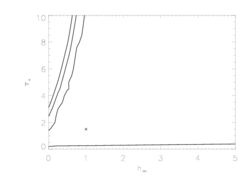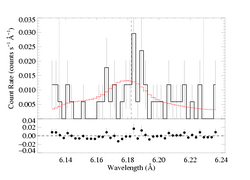Si XIV 6.182 Angstroms
Models with anisotropic porosity
Note: Both MEG and HEG are fit simultaneously. There are 109 MEG counts and 49 HEG counts in the spectral region we fit (and plot below). See the fitting log.
Same continuum fit as we used for the non-porous models and the isoporous models: n=2, best-fit norm=7.62e-4. View the spectral region near the line: MEG or HEG.
Note that very high values of optical depth and porosity length are mildly preferred. But the unrealistic global best-fit shown here shows only a 0.5 improvement in ΔC over the non-porous best-fit model.
Here are the 68%, 90%, and 95% joint confidence limits on taustar and uo based on fitting the MEG and HEG data together. The asterisk indicating the best-fit model is at a high optical depth, but even higher values (off the grid) provide slightly better fits.

|
Compare these confidence regions to the ones we derived for the non-porous models. These are much less constraining, because larger values of taustar are possible when porosity is included. The more relevant confidence limits for these porous models, though, are the ones projected into taustar - h space:

|
Here too, of course, the model fitting rules out very little of parameter space: just the high optical depth, no porosity portion and also regions with very small optical depths.
Back to main page.
last modified: 4 June 2008

